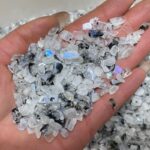Introduction
Sodalite, an alluring azure gemstone, has captivated collectors and jewelry enthusiasts alike with its intense blue hue and vitreous luster. Beyond its captivating appearance, sodalite exhibits remarkable durability, making it suitable for a wide range of applications. This article delves into the enigmatic world of sodalite hardness, exploring its various aspects, practical implications, and innovative uses.

Understanding Sodalite’s Hardness
Hardness, a crucial property of materials, measures their resistance to scratching and deformation. According to the Mohs scale of mineral hardness, sodalite ranks between 5.5 and 6, indicating its ability to withstand scratching by steel but not by hard minerals like quartz or topaz. This moderate hardness allows sodalite to maintain its shape and integrity in many situations.
Factors Influencing Sodalite Hardness
Several factors contribute to sodalite’s hardness, including:
- Crystal Structure: Sodalite’s cubic crystal structure forms a rigid framework, providing strong bonds between its constituent atoms.
- Chemical Composition: Composed primarily of sodium, aluminum, and chlorine, sodalite’s chemical bonding contributes to its structural stability.
- Impurities: Trace elements and mineral inclusions can influence sodalite’s hardness, either strengthening or weakening its crystal structure.
Practical Implications of Sodalite Hardness
The hardness of sodalite has profound implications for its practical applications:
- Jewelry: Sodalite’s moderate hardness makes it suitable for use in jewelry, where it can withstand daily wear and tear without easily scratching.
- Sculptures and Artifacts: Due to its durability, sodalite can be carved into intricate sculptures or used in decorative arts, preserving its beauty over time.
- Construction Materials: In certain cases, sodalite has been employed as a decorative facing material in buildings, benefiting from its ability to resist abrasion and weathering.
Innovative Applications of Sodalite Hardness
Advancements in technology have opened up new avenues for sodalite’s application, leverging its unique hardness properties:
- Nanocomposite Materials: Sodalite nanoparticles have been integrated into composite materials to enhance their mechanical strength and thermal conductivity.
- Electronic Devices: Sodalite’s electrical conductivity and optical transparency make it a promising candidate for electronic components.
- Medical Applications: Researchers are exploring sodalite’s potential in biomedical devices, particularly in bone tissue engineering.
Tips and Tricks for Maintaining Sodalite Hardness
To preserve sodalite’s durability, consider the following tips:
- Avoid Abrasive Cleaners: Use mild soap and water for cleaning, as harsh chemicals or abrasive cleaners can scratch its surface.
- Store Carefully: Store sodalite in a padded case or wrap it in soft tissue to protect it from knocks and scratches.
- Limit Exposure to Extreme Conditions: Avoid exposing sodalite to extreme heat or cold, as thermal stress can weaken its structure.
FAQs on Sodalite Hardness
-
How hard is sodalite on the Mohs scale?
Sodalite ranks between 5.5 and 6 on the Mohs scale. -
Can sodalite be scratched by a fingernail?
No, sodalite cannot be scratched by a fingernail, as it has a higher hardness than 2.5. -
Is sodalite harder than calcite?
Yes, sodalite is harder than calcite, which has a Mohs hardness of 3. -
Can sodalite be cut or shaped?
Yes, sodalite can be cut or shaped using specialized tools and techniques. -
What are some applications of sodalite’s hardness?
Jewelry, sculptures, construction materials, nanocomposite materials, electronic devices, and medical applications. -
How should sodalite be stored to maintain its hardness?
Store sodalite in a padded case or wrap it in soft tissue to protect it from knocks and scratches.
Conclusion
Sodalite’s captivating hue and moderate hardness make it a versatile gemstone with a wide range of applications. Understanding sodalite hardness enables us to appreciate its durability and explore its potential in various fields. From adorning our bodies to enhancing technological advancements, sodalite’s unique properties continue to inspire innovation and captivate our imagination.




























